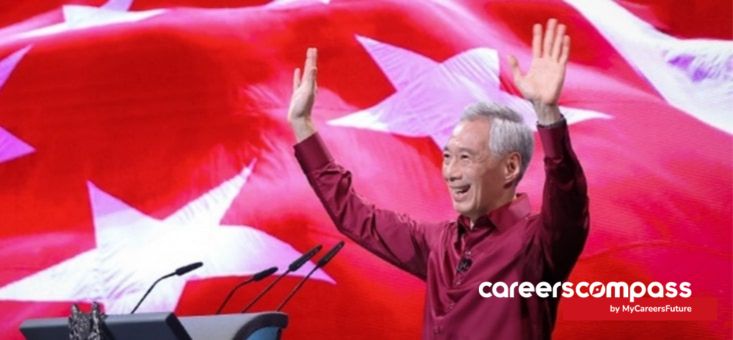In his recent May Day rally speech earlier this year, Singapore Prime Minister (PM) Lee Hsien Loong shared the importance of business transformation and upskilling, saying “the two of them must go hand-in-hand”.
So when new jobs are created, workers are equipped to take them up, and where there is technology and progress, workers are not displaced.
He took a further step in illustrating this ethos during his National Day Rally speech on 21 Aug at the Institute of Technical Education headquarters, revealing updates on how plans for Tuas Port would improve and change Singapore’s seaport and airport, and affect workers employed in these industries.
PM Lee said: “Our seaport and airport play a critical role putting us on the global stage. They connect us to the world and keep Singapore a thriving business and trading hub.
“Let me take our seaport first. It serves not just Singapore, but many countries around us. A decade ago, Asia was growing strongly, and we anticipated that PSA’s business would grow with it. The existing terminals at Tanjong Pagar, Brani, Keppel and Pasir Panjang were working fine.
“But we decided nevertheless to consolidate all our port operations into one mega port at Tuas.”
The goal, he elaborated, was to progressively free up prime waterfront land from Shenton Way to Pasir Panjang for the future Greater Southern Waterfront.
“Tuas Port is now up and running. The first two berths started operations last December, ships are calling there from all over the world,” PM Lee said.
“Because we had planned ahead, our port was able to handle extra volumes during the pandemic. While ports in other countries experienced closures, severe congestion and long delays, but the Port of Singapore Authority (PSA) remained open 24/7 throughout!
“This reinforced Singapore’s position as the “catch-up port” where vessels made up time for delays elsewhere.
“In fact, last year, Singapore handled a record high of 37.5 million twenty-foot equivalent unit (TEUs) of containers. We kept our position as the world’s busiest transhipment hub.”
The Prime Minister shared more about Tuas Port, and the modernizing and upgrading of its port operations, revealing how it is automated and digitalized, using artificial intelligence (AI) to coordinate operations more seamlessly, including vessel traffic management and port clearance.
Looking for a new role? Explore over 100,000 jobs available on MyCareersFuture now!
Instead of trucks with drivers, it deploys a fleet of driverless automated guided vehicles (AGVs). This means they are driver-less, and “move around magically by themselves”, he lauded.
He praised port workers, unions, PSA and the Maritime and Port Authority for their efforts in making these changes happen, saying: “Management and unions worked hand-in-glove to retrain workers and help them adapt to new working environment.
“On their part, workers picked up new skills, upgraded themselves, and became more productive!”
New goals and challenges for Singaporean workers
This complimented his earlier National Day message on Singapore’s economic outlook, and what local workers need to do to stay competitive, by “transforming our industries, upgrading skills and raising productivity”.
He reiterated the importance of this mindset, especially in terms of keeping salaries in line with inflation, saying to local workers at his Rally speech: “We do not have much influence over global inflation.”
“What is within our power is to make ourselves more productive and competitive, because then our workers can earn more, and more than make up for the higher prices of food, fuel and other imports.
“That way we can all become better off, in real terms.
“This requires us to press on with economic upgrading and restructuring; redouble our transformation efforts; and encourage workers to upgrade their skills at every opportunity!”
PM Lee also gave further insight towards the future targets for Tuas Port and Changi Airport.
He added: “We have just completed Phase I of Tuas Port; Phases II, III and IV will follow. When fully completed around 20 years from now, Tuas Port will handle 65 million TEUs annually – almost double today’s volumes.
“We will have the world’s largest fully automated port, and that should make us a leading global player in the maritime space!”
For those in the aviation sector, he shared ambitious new plans for Changi Airport, saying: “Even before we broke ground for Terminal 4 and Jewel, we already envisaged building Terminal 5.”
He revealed the new terminal would be as big as all the other current terminals (T 1-4) put together, in terms of capacity.
Work-from-home could be complemented with working nearer to home
Next to this new terminal, plans were shared to develop a new Changi East Urban district.
This would mark a new business and lifestyle destination, creating more jobs and opportunities for Singaporeans.
In addition, the Prime Minister shared how Paya Lebar will be redeveloped: “We can build around 150,000 new homes, with amenities and recreational areas close by, as well as commercial and industrial developments, to bring jobs closer to our homes.”
Such work and lifestyle synergies are happening across Singapore, he added, referencing developments in Jurong Lake District, Greater Southern Waterfront, and many other areas.
PM Lee concluded: “Each new estate will be more liveable, greener, and more sustainable than the previous one.
“This is not easy to do, but just as past generations planned for and created the Singapore that we live in today, we too, must never stop imagining and building the future Singapore for the next generation and beyond!”
(Main Image Credit: MDDI)















